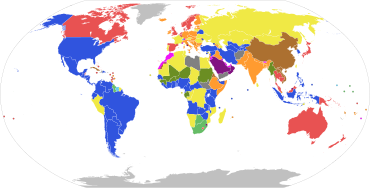
Parliamentary systems: Head of government is elected or nominated by and accountable to the legislature
Constitutional monarchy with a ceremonial monarch
Parliamentary republic with a ceremonial president
Presidential system: Head of government (president) is popularly elected and independent of the legislature
Presidential republic
Hybrid systems:
Semi-presidential republic: Executive president is independent of the legislature; head of government is appointed by the president and is accountable to the legislature
Assembly-independent republic: Head of government (president or directory) is elected by the legislature, but is not accountable to it
Other systems:
Semi-constitutional monarchy: Monarch holds significant executive or legislative power
Absolute monarchy: Monarch has unlimited power
One-party state: Power is constitutionally linked to a single political party
Military junta: Committee of military leaders controls the government; constitutional provisions are suspended
Provisional government: No constitutionally defined basis to current regime
Dependent territories or places without governments
Note: this chart represents the de jure systems of government, not the de facto degree of democracy.
| Part of the Politics series |
| Politics |
|---|
|
|
Semi-parliamentary system can refer to one of the following:
- a prime-ministerial system, in which voters simultaneously vote for both members of legislature and the prime minister[1]
- a system of government in which the legislature is split into two parts that are both directly elected – one that has the power to remove the members of the executive by a vote of no confidence and another that does not.[2]
The former was first proposed by Maurice Duverger, who used it to refer to Israel from 1996 to 2001.[1] The second was identified by German academic Steffen Ganghof.[2]
Like semi-presidential systems, semi-parliamentary systems are a strongly rationalized form of parliamentary systems. After Israel decided to abolish the direct election of prime ministers in 2001, there are no national prime-ministerial systems in the world; however, a prime-ministerial system is used in Israeli and Italian cities and towns to elect mayors and councils.
- ^ a b Duverger, Maurice (September 1996). "Les monarchies républicaines" [The Republican Monarchies] (PDF). Pouvoirs, revue française d'études constitutionnelles et politiques (in French). No. 78. Paris: Éditions du Seuil. pp. 107–120. ISBN 2-02-030123-7. ISSN 0152-0768. Archived from the original (PDF) on 1 October 2018. Retrieved 10 September 2016.
- ^ a b Ganghof, S (May 2018). "A new political system model: Semi-parliamentary government". European Journal of Political Research. 57 (2): 261–281. doi:10.1111/1475-6765.12224.